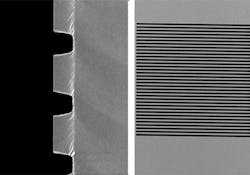Compliant laser-cavity mirror couples light to mechanical mirror mode
| Gratings are fabricated with approximately 700 nm between ridges (left). Each has slightly different spacing and thickness, affecting reflectivity and mechanical performance. A single grating measuring 50 micrometers on a side (right). (Image: PML) |
Gaithersburg, MD--A new lightweight micromechanical laser-cavity mirror created at the Quantum Measurement Division of the Physical Measurement Laboratory (PML) efficiently couples the mirror's mechanical-resonance frequency with the optical-resonance frequency of the cavity.1 The device could be useful in engineering new types of optomechanical systems. PML is part of the National Institute of Standards and Technology (NIST).
A typical lab setup for this kind of work involves an optical cavity with two mirrors: a fixed mirror on one end, and a movable mirror on the other. Laser light injected into the cavity reflects back and forth, pushing on the mirrors as it goes. The resulting displacement in the movable mirror changes the distance between the mirrors, which in turn affects the resonance frequency of the cavity.
Previous researchers used a moving mirror made up of 16 to 40 layers of dielectric film. That's not exactly huge, but the more layers that are added (to boost reflection), the heavier it gets. "And we need really low mass because the optical force is so weak," says John Lawall, one of the PML researchers.
Michael Metcalfe, a former postdoc in Lawall's group, pointed out that with careful design, gratings can work as mirrors as long as the grating period is below the wavelength of light, which in the team's case is about 1560 nm. With colleagues at NIST's Center for Nanoscale Science and Technology, Lawall's group produced a grating with a spacing of about 700 nm, beginning with a membrane of silicon nitride (a material known to have exceedingly low mechanical losses) and then etching it with reactive ions. (The original membrane has a reflectivity of about 27%; the final product has a reflectivity of 99.6% and has a smaller mass.)
Eventually 81 such gratings, each with slightly different finger widths and spacings, were arranged on a single membrane. In this way the researchers could experimentally determine the reflectivity corresponding to a particular grating design, and choose a grating to couple optimally to a particular mechanical mode of the membrane.
The result is a micromechanical reflector that is more than an order of magnitude less massive than conventional stack reflectors, has a mechanical quality factor (Q = 7.8 X 105) two orders of magnitude higher, and reflects 99.6% of the incident light. "We are not the first people to use gratings as reflectors, but we think we are the first to study them closely for their mechanical properties as well as their optical properties," says Utku Kemiktarak, one of the researchers.
REFERENCE:
1. Utku Kemiktarak et al., App. Phys. Lett. 100, 061124 (2012).
